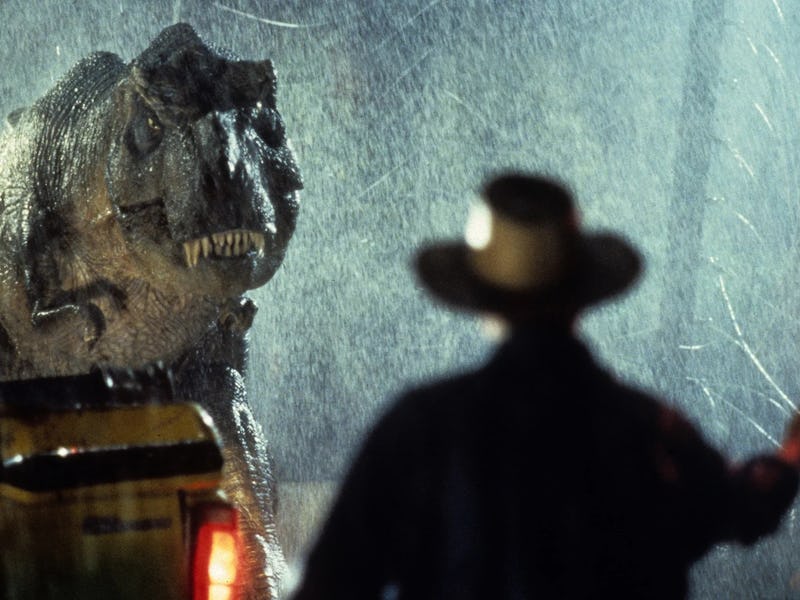Steven Spielberg’s Perfect Monster Movie Still Holds Up
Practical effects from 1993 can invoke far more awe than today’s weightlesss CGI blobs.

30 years ago, Steven Spielberg brought dinosaurs back to life. That may be overstating things, but not by much. Throughout his career, Spielberg brought more than his fair share of iconic creatures and characters to the big screen. But none of the director’s many achievements have ever matched the scale and magic of the dinosaurs in Jurassic Park, and none have managed to viscerally conjure quite the same feelings of wonder and fear.
Based on Michael Crichton’s novel, Jurassic Park needed to get a lot right to succeed. At the top of that list were the film’s dinosaurs, which needed to look real enough that moviegoers could experience the same terror and awe as its characters. Nowadays, that might not seem like that big of an ask. But when computer-generated imagery was still in its infancy, it was one of the most difficult challenges Spielberg had ever elected to take on.
Not only did he and the film’s artists rise to meet that challenge, but they demonstrated an understanding of the merits of both digital and practical effects that feels increasingly rare today. Even more importantly, Spielberg used photoreal dinosaurs to bring Hollywood’s classic monster movie genre into the present. In doing so, Jurassic Park told a story about the dangers of reckless technological advancement that feels even more relevant now than it did in 1993.
1993 famously saw Spielberg release two totally different movies: Jurassic Park and Schindler’s List. In a documentary about making the former, Spielberg noted that he used “every ounce of intuition on Schindler's List and every ounce of craft on Jurassic Park.” His focus on craft is evident in every frame. Spielberg not only recruited visual effect legends like Phil Tippett and Stan Winston to help create Jurassic Park’s dinosaurs, but he invested further in the then-growing digital sound industry to ensure the film’s sound mix made audiences feel engrossed in its story and world.
These decisions paid off. The film’s combination of animatronic models and then-cutting-edge CGI resulted in effects that hold up surprisingly well. Not only do many of its dinosaurs often look just as convincing now as they did back in 1993, but the film’s sound mix ensures you feel every bone-rattling step they take. Combined with Spielberg’s unrivaled skills as an action filmmaker, Jurassic Park’s many technological achievements turn it into a monster movie that’s also a genuinely thrilling sensory experience.
Jurassic Park remains timeless.
Like all of Spielberg’s best films, Jurassic Park isn’t just a visual showcase. Beneath all its moments of spectacle are ideas about the dangers that can arise when greed and science intersect. The script, penned by Crichton and David Koepp, builds all its characters, subplots, and big moments around the same themes. Our heroes not only learn just how dangerous it is to use technology to recreate organic life, but some, like Sam Neill’s Alan Grant, also learn to appreciate the life that already exists around them.
Visually, Spielberg consistently reinforces these ideas, but never more pointedly than when a velociraptor steps into a projector light and briefly turns into nothing more than lines of code. It’s a clever little moment that most of the film’s blunt sequels have lacked.
Dinosaurs have never felt as real as they do in Jurassic Park.
Like its effects, Jurassic Park’s ideas haven’t really aged. With subjects like artificial intelligence and artificial life becoming more relevant every day, the film only seems more relevant now. Spielberg’s dedication to the look and feel of Jurassic Park has similarly aged well, if only because Hollywood at large has moved away from the methods and practices that gave the film such a tactile sense of reality.
The industry’s growing dependence on digital effects has made an increasing number of films feel fake and lifeless in all the ways that Jurassic Park’s dinosaurs don’t. That’s been a disappointing trend, as has Hollywood’s insistence on producing interminable sequels. Even the Jurassic Park franchise has fallen prey to the industry’s IP obsession, despite its first installment exploring, among other things, what can go wrong when money becomes all anyone cares about.
Jurassic Park avoided the mistakes of its imitators and successors, which is why it still works just as well now as it did in 1993. It’s a film that not only offers the same pleasures as the genre classics Spielberg grew up watching, but that uses groundbreaking filmmaking techniques to convey a timeless message.